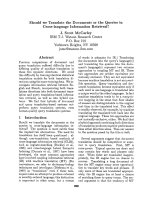Technical Analysis Plain and Simple_ Charting the Markets in Your Language (3rd Edition)
Bạn đang xem bản rút gọn của tài liệu. Xem và tải ngay bản đầy đủ của tài liệu tại đây (1.98 MB, 353 trang )
From the Library of Lee Bogdanoff
TECHNICAL
ANALYSIS PLAIN
AND SIMPLE,
THIRD EDITION
CHARTING THE MARKETS IN
YOUR LANGUAGE
Michael N. Kahn, CMT
From the Library of Lee Bogdanoff
Vice President, Publisher: Tim Moore
Associate Publisher and Director of Marketing: Amy Neidlinger
Executive Editor: Jim Boyd
Editorial Assistants: Myesha Graham, Pamela Boland
Operations Manager: Gina Kanouse
Senior Marketing Manager: Julie Phifer
Publicity Manager: Laura Czaja
Assistant Marketing Manager: Megan Colvin
Cover Designer: Chuti Prasertsith
Managing Editor: Kristy Hart
Project Editor: Betsy Harris
Copy Editor: Apostrophe Editing Services
Proofreader: Williams Woods Publishing Services
Senior Indexer: Cheryl Lenser
Compositor: Nonie Ratcliff
Manufacturing Buyer: Dan Uhrig
© 2010 by Pearson Education, Inc.
Publishing as FT Press
Upper Saddle River, New Jersey 07458
This book is sold with the understanding that neither the author nor the publisher is engaged
in rendering legal, accounting, or other professional services or advice by publishing this
book. Each individual situation is unique. Thus, if legal or financial advice or other expert
assistance is required in a specific situation, the services of a competent professional should
be sought to ensure that the situation has been evaluated carefully and appropriately. The
author and the publisher disclaim any liability, loss, or risk resulting directly or indirectly,
from the use or application of any of the contents of this book.
FT Press offers excellent discounts on this book when ordered in quantity for bulk purchases or
special sales. For more information, please contact U.S. Corporate and Government Sales, 1-800382-3419, For sales outside the U.S., please contact
International Sales at
Company and product names mentioned herein are the trademarks or registered trademarks of
their respective owners.
All rights reserved. No part of this book may be reproduced, in any form or by any means, without permission in writing from the publisher.
Printed in the United States of America
First Printing January 2010
ISBN-10: 0-13-704201-9
ISBN-13: 978-0-13-704201-2
Pearson Education LTD.
Pearson Education Australia PTY, Limited
Pearson Education Singapore, Pte. Ltd.
Pearson Education North Asia, Ltd.
Pearson Education Canada, Ltd.
Pearson Educatión de Mexico, S.A. de C.V.
Pearson Education—Japan
Pearson Education Malaysia, Pte. Ltd.
Library of Congress Cataloging-in-Publication Data
Kahn, Michael N.
Technical analysis plain and simple : charting the markets in your language / Michael N. Kahn.
— 3rd ed.
p. cm.
ISBN-13: 978-0-13-704201-2 (hardback : alk. paper)
ISBN-10: 0-13-704201-9
1. Investment analysis. I. Title.
HG4529.K34 2010
332.63’2042—dc22
2009029711
From the Library of Lee Bogdanoff
This book is dedicated to my father,
Arthur M. Kahn, who would have
loved to see it in print.
From the Library of Lee Bogdanoff
This page intentionally left blank
From the Library of Lee Bogdanoff
CONTENTS
Acknowledgments
xvii
About the Author
xix
Preface
xxi
About This Book
xxv
How to Get the Most from This Book
xxxi
Part I
A FEW THINGS YOU’LL NEED TO KNOW
BEFORE YOU BEGIN
1
1
REQUIRED BACKGROUND
3
The Past
3
Technical Market Theory
6
The Pillars of Technical Analysis
10
For Fundamentalists
10
v
From the Library of Lee Bogdanoff
2
WHAT IS TECHNICAL ANALYSIS?
13
Components
14
What Is the Market?
16
3
WHAT IS A CHART?
19
A Picture Is Worth a Thousand Words
19
What Good Is That?
20
Tea Leaves? Crystal Ball?
21
What About Earnings?
22
Conclusion
23
4
vi
JARGON YOU CANNOT AVOID
25
Bar Chart
25
Support and Resistance
26
Trends
27
Consolidation, Congestion, Correction
29
Breakout
29
Continuation Patterns
30
Reversal Patterns
31
Moving Averages
31
Momentum
31
Divergence
32
TECHNICAL ANALYSIS PLAIN AND SIMPLE
From the Library of Lee Bogdanoff
Part II
THE CORE OF CHART ANALYSIS
33
5
CONCEPTS
35
What Is Really Going on to Form the Charts?
35
Indecision and Alignment of Needs
36
Taking the Easy Way Out
37
The Herding Effect
37
Markets Are Scalable
40
6
WHAT ARE SUPPLY AND DEMAND
IN THE MARKETS?
41
What Causes Support and Resistance Levels to Be Penetrated?
42
Perceptions Are Reality
43
7
THE TREND IS YOUR FRIEND
AND SO ARE TRENDLINES
47
Trendlines
47
Fan Lines
52
Contents
vii
From the Library of Lee Bogdanoff
8
SEE THE FOREST AND THE TREES
55
Less Is More
55
Multiple Time Frames
57
Moving Averages
58
9
CHART PATTERNS—WHEN THE
MARKET NEEDS A REST
63
Rectangles
64
Triangles
65
Flags
66
Cup with Handle
67
10
viii
CHART PATTERNS—WHEN THE MARKET
IS CHANGING ITS MIND
73
Head and Shoulders
73
Double Tops and Bottoms
76
One-Day Reversals
78
Triangles and Rectangles
79
Rounded Tops and Bottoms
79
Spikes
80
TECHNICAL ANALYSIS PLAIN AND SIMPLE
From the Library of Lee Bogdanoff
11
CHART PATTERNS—EXPLOSIONS
83
Breakaway Gaps
83
Continuation Gaps
85
Exhaustion Gaps
85
Other Gaps
87
12
CORRECTIONS IN PERSPECTIVE
89
The Right Way
89
The Wrong Way
91
Part III
TECHNICAL ANALYSIS IN THE REAL WORLD
95
13
WHAT IS THERE OTHER THAN PRICE?
97
The Big Picture
98
Does the Market Have Bad Breadth?
98
Sectors and Industry Groups
102
Momentum
103
Divergence
104
Contents
ix
From the Library of Lee Bogdanoff
14
VOLUME
109
Accumulation and Distribution
110
Cumulative Volume
111
15
TIME
117
Proportion
117
Cycles
119
16
SENTIMENT
121
Sentiment Indicators
121
Measuring Expectations That Drive Markets
123
Subjective
128
Social Mood
129
17
x
FUNDAMENTAL ANALYSIS REALLY
IS TECHNICAL ANALYSIS
131
Intermarket Analysis
132
The Major Markets
132
Intramarket Relationships
135
Prove It!
135
TECHNICAL ANALYSIS PLAIN AND SIMPLE
From the Library of Lee Bogdanoff
18
JUST WHAT MAKES A STOCK (BOND,
COMMODITY) LOOK GOOD?
137
Trend and Momentum
138
Volume
141
Relative Strength (the Market, Sectors, and
Individual Stocks)
142
Sector Selection
147
Basing and Breakouts
148
19
RISK VERSUS REWARD—IS THIS STOCK
REALLY WORTH IT?
149
How Can Potential Profit Be Measured?
149
Is That a Good Trade?
153
Sometimes the Best Trade Is the One You Don’t Make
157
20
THIS ISN’T BRAIN SURGERY
161
Technician’s License
161
Let the Market Talk
164
Theme and Variation
167
In the Real World, Nothing Is Textbook so Stay Flexible
171
Contents
xi
From the Library of Lee Bogdanoff
Part IV
THE ACTUAL PROCESS OF INVESTING
175
21
OK, NOW DO IT!
177
The Questions
177
No Fear
178
22
HOW TO KNOW IF YOU ARE WRONG
183
Invalidating a Trendline
183
23
SOMETIMES BEING WRONG IS GOOD
187
Failure That Forewarns
187
Failure That Cuts Losses
189
Summary
190
24
xii
WHEN TO SELL
191
The Trend Is at Its End
191
Price Objective Is Reached
200
Stop Is Hit
201
Would You Buy It Right Now, at Its Current Price?
202
TECHNICAL ANALYSIS PLAIN AND SIMPLE
From the Library of Lee Bogdanoff
25
BEAR MARKETS
203
What Happens in a Bear Market?
204
26
A WORD ABOUT YOUR EGO
209
Remember Why You Are Investing
209
Part V
TOOLS AND CASE STUDIES
211
27
WHAT DO I REALLY NEED TO GET STARTED? 213
Real-Time Data
213
Charting Software
214
Internet
217
Your Child’s Geometry Tools
217
28
BUILDING YOUR TECHNICAL TOOLBOX
219
Technical Tasks
219
Tools for Each Technical Task
221
Combination Tools
223
Contents
xiii
From the Library of Lee Bogdanoff
29
FINAL ADVICE
225
30
CASE STUDY—THE PERFECT WORLD
227
Are Conditions Favorable for Equity Assets?
228
What Sectors of the Market Are Good?
231
What Stocks Within the Good Sectors Are the Best to Buy?
231
Risk Assessment
232
Pull the Trigger
233
31
CASE STUDY—THE REAL WORLD
235
32
CASE STUDY—BIZARRO WORLD
249
33
xiv
HOW GOOD IS YOUR BROKER’S STOCK?
253
When Your Broker’s Recommendation Looks
Like Nothing Special
253
Breakout Warning
255
Confirmation Required
256
What Makes a Stock Look Good?
256
Compare It to the Market
257
Compare Them to Each Other
257
TECHNICAL ANALYSIS PLAIN AND SIMPLE
From the Library of Lee Bogdanoff
Part VI
FURTHER ON DOWN THE ROAD
259
34
INTRODUCTION TO CANDLESTICKS
261
Reading Candlesticks
262
Basic Candlestick Shapes
263
Reversal Indicators
264
Continuation Indicators
266
Dojis
267
Trading with Candlesticks
267
35
CYCLES
271
What Is a Cycle?
271
Summary
274
36
ELLIOTT WAVES
275
Introduction
275
37
TECHNICAL TERMS YOU MAY HAVE HEARD
279
Open Interest
279
Bollinger Bands
280
Relative Strength Index (RSI)
281
Contents
xv
From the Library of Lee Bogdanoff
Stochastics
282
RSI Versus Stochastics
283
Fan Lines
285
Fibonacci Retracements
286
MACD
288
Tick
292
Trin (Arms Index)
292
Pivot Points
293
Point and Figure
293
38
xvi
DEBUNKING THE TV ANALYST
299
FUN WITH JARGON
303
Double Reverse Whirligig
303
Bear Trap
303
Dead-Cat Bounce
304
Whipsaw
307
Catapult
308
Saucers
309
Candlestick Terms
309
CLOSING THOUGHTS
311
INDEX
313
TECHNICAL ANALYSIS PLAIN AND SIMPLE
From the Library of Lee Bogdanoff
ACKNOWLEDGMENTS
As with just about all books ever written, the author did not complete
his work alone. This book is no exception.
First and foremost, I would like to thank my wife Susan for all she did
to help bring this work to fruition. Although it might be trite to thank
a spouse who did none of the research nor wrote any of the words,
Susan gave me a few things that were more valuable. She took on some
of my responsibilities around the house and with the children to give
me time to work in the evenings. Support for my vision and critiques
for my output were also a necessity, and on top of that, her gentle “persuasion” to get the work done on time.
Next, I would like to thank the very professional staff at FT Press for
first accepting my proposal and then dealing with me fairly and openly.
Marc Davidson donated his time to proofread the text, not for spelling
and grammar, but to keep me focused on my intended audience.
To Brian Goldstein and, believe it or not, my mother Natalie Kahn, who
has been incredibly successful at picking stocks without knowing anything I wrote about in this book; thank you for letting me pick your
brains.
As for nonindividual investors, I would like to thank Bridge
Information Systems and eSignal for allowing me to use their charts
and data here.
Finally, to my colleagues, both past and present, in the discipline of
technical analysis, thank you for your pioneering work that served as
the base for my own methods. There are some pretty smart people out
there making their clients very wealthy and discovering some amazing
secrets to pass along to their students.
xvii
From the Library of Lee Bogdanoff
This page intentionally left blank
From the Library of Lee Bogdanoff
ABOUT THE AUTHOR
Michael N. Kahn, CMT, a Chartered Market Technician, currently
writes the twice-weekly column “Getting Technical” for Barron’s
Online. Mr. Kahn also produces a daily proprietary technical market
newsletter, Quick Takes Pro (www.QuickTakesPro.com).
Previously, he was chief technical analyst for BridgeNews, a division of
Bridge Information Systems, a leading source of global financial information, transaction services, and network services.
He has been a regular guest on the Nightly Business Report on PBS, has
appeared on CNBC, and was the editor of the Market Technicians
Association newsletter, Technically Speaking. His first book, Real World
Technical Analysis, was published in January 1998, by Bridge/
Commodity Research Bureau Publishing.
Prior to writing technical commentary, Mr. Kahn was a senior product
manager for Knight-Ridder Financial before that company was merged
into Bridge. He was responsible for the marketing design of several of
the firm’s charting software platforms and launched technical analysis
coverage for Knight-Ridder Financial News. He was also a co-editor of
the Tradecenter Market Letter.
Prior to joining Bridge/Knight-Ridder Financial in 1986, Mr. Kahn was
a senior municipal bond specialist with Merrill Lynch. He also worked
in the Financial Planning Department at Shearson Lehman American
Express.
Mr. Kahn holds a Bachelor of Arts degree in physics and economics
from Brandeis University and a Master of Business Administration
from New York University.
xix
From the Library of Lee Bogdanoff
This page intentionally left blank
From the Library of Lee Bogdanoff
PREFACE
echnical analysis is one of the oldest market disciplines, yet the
majority of the investment and academic communities consider it, at best, a minor supplement to their own work. At worst,
it is disparaged as tea-leaf reading or simply a self-fulfilling prophecy.
Look at these two phrases. They suggest that the technical analyst
divines the market from some mystical process. This could not be further from the truth.
T
Consider the fundamental analyst. This person relies on company
reports, conversations with company insiders, and macro-economic
research in relevant business sectors. All this is indispensable when
determining if a company is viable and predicting how its business will
fare in the future.
Now consider the source of all the raw data. Much of it is projection
and conjecture. How can you rely solely on such raw data when earnings reports and other industrywide data will be subject to revisions?
Technical analysis looks at actual trades in which bulls and bears have
put their money where their collective mouths are. There is no revision
of data. There is no ambiguity. There is no mystical divining of the
future. All market and stock selection is based on current, not past,
price performance, the predictable behavior of market participants,
and the dynamics between markets over time.
Trends exist. Information is slowly disseminated to the public in an
imperfect manner, and as the public acts on the information, the markets move. They continue to move until either the last group has acted
or an outside influence, such as news, ends the trend. Sounds a lot like
physics, does it not? A body in motion tends to remain in motion.
Look at another aspect of the analysis. Behavior is a key component of
the analysis. When similar market conditions occur, market participants react in similar ways. This is how the patterns and measurements
within technical analysis are created.
xxi
From the Library of Lee Bogdanoff
For example, the market holds fairly steady as buyers and sellers adjust
their portfolios to meet their specific investment criteria. A stock might
trade from 50 to 52 for weeks in this way. Is the stock good? Is the company good? You do not know. All you know is that bulls and bears consider the stock to be fairly valued within a small range. A body at rest
tends to stay at rest—physics again.
Now somebody comes into the market to buy a large block of stock.
Why? Technical analysis does not know but more important, it does not
care. All it needs to know is that money has flowed into the market and
increased demand for the stock. Demand? That is straight from basic
economics. If demand rises, the price must rise to induce sufficient supply (sellers) to come into the market and restore equilibrium. This does
not sound very mystical, does it?
So, now that demand has increased, market activity picks up to provide
supply. It also changes in character as people try to decipher what is
happening. Here are the familiar concepts of fear and greed, both key
determinants of human behavior. Some participants think that something has changed and the stock is now undervalued. It could be a new
product or simply a decrease in the company’s raw material inputs.
Perhaps it is foreign capital coming into the stock. Or a shortage of the
stock itself. Whatever the reason, some market participants know
something, or think they know something, about improved prospects
for the company and they buy. The market breaks out of the trading
range, and as it does, more market participants act. The size and scope
of their actions is often similar to the size and scope of their actions at
other occasions in which the market has broken out of similar ranges.
It can be measured and projected.
Technical analysis has an unfortunate name. Perhaps “price action
analysis” or “supply, demand, and reaction analysis” might be better. In
1998, great strides were made between market technicians and the academic community in the emerging field of behavioral finance. Now
there is a possible name to use.
One aspect of the technical discipline is explaining the difference
between valuations and actual market prices. If a stock is worth 75 on
paper based on discounted cash flows, projected growth, and overall
economic conditions, why is it trading at 90? The difference is in the
xxii
TECHNICAL ANALYSIS PLAIN AND SIMPLE
From the Library of Lee Bogdanoff
market’s perceptions of the stock. People have pushed the stock up past
its theoretical value. Technical analysis is perfectly suited to handle this.
Because people’s perceptions can change quickly, it is also perfectly
suited to reacting equally as quickly. This type of reaction speed is
impossible using fundamental analysis alone.
Do you scrap your fundamentals and rely exclusively on technicals?
Absolutely not! Although there are scores of money managers and
traders that are 100 percent technical and making a lot of money, you,
the reader, are not interested in making technical analysis your sole
investment discipline just yet. You are reading this book because you
are seriously interested in enhancing your returns, not searching for a
completely new method. Perhaps one day you will make that switch,
but that is beyond the scope of this book.
At this stage, charts give you a clear picture of what your fundamental
research is saying. Remember that the fundamentals describe the company. Technicals describe how the stock performs. You are buying stock,
not companies.
But why does this book need a third edition? If technical analysis is not
subject to revision, then its concepts should have near-permanent shelf
life. Unfortunately, the markets are ever–evolving, and analysts are
always learning new things about how it operates. After all, wasn’t the
world considered to be flat at one point by the best minds of the time?
Or that leeches healed disease? You get the point. As the markets
change, so, too, must the analysis.
Between the first and second editions, most of us experienced our first
live bear market for stocks. Between the second and third editions, we
experienced a near breakdown of both the financial markets and the
usefulness of our analytical tools. This edition incorporates everything
new I have learned about the markets and how to analyze them. It is
likely not going to be the last edition because the markets will not stop
changing. Remember the old saw, “Whenever you find the key to the
market, they change the locks.”
Preface
xxiii
From the Library of Lee Bogdanoff
This page intentionally left blank
From the Library of Lee Bogdanoff









